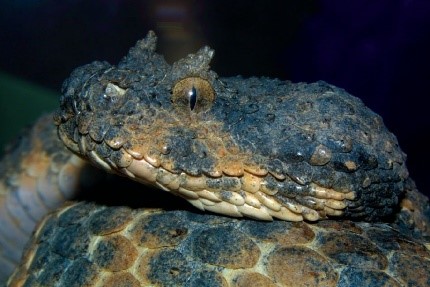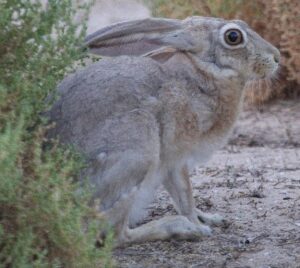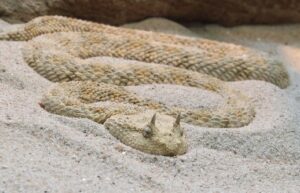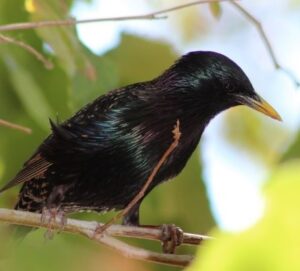Technically, all of the animals that live in and around our buildings are part of the wildlife, but some vertebrate pests that are serious pests in particular situations are never considered pests by certain people. Pigeons, for example, can cause human health problems when roosting in large numbers, but also seen as pets and friends by those who feed them daily. These constituents react angrily to any attempt to poison or trap pigeons. Certain people feel a strong attachment towards vertebrates that they do not feel towards other pests. Children in particular love and cherish them. Many people today are involved emotionally in the welfare of animals, particularly domestic pets, and in conserving wildlife. Control of these animals, other than rodents, can be more of a public relations problem than a pest problem. Killing is the method of last resort and, in few cases, is illegal. Public concern for the welfare of animals and the risk from vertebrate poisons to people, pets, and other nontarget animals have made rules governing vertebrate pest control particularly strict. Pest control professionals should understand the laws and regulations at the local and federal levels on how to deal with these types of pests. Pest control professional face a challenge when trying to solve any people-wildlife conflict, especially when dealing with bats, rabbits, feral cats, and snakes. Prior to tackling an urban wildlife problem, ETS trained nuisance wildlife control professionals have the knowledge to identify the pest, entry points, the type and amount of damage occurring, the additional damage (if any) anticipated if no action is taken, and determine if non-target animals at any risk as a result of the management plan they propose. We can provide valuable information to clients when they need help or advice regarding wildlife pests around homes or works, and recommend the required work to prevent future nuisance animal conflicts.
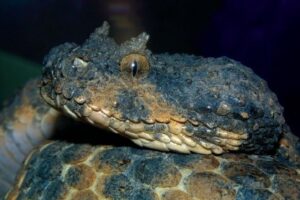 |
 |
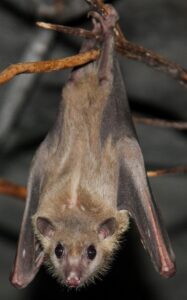 |
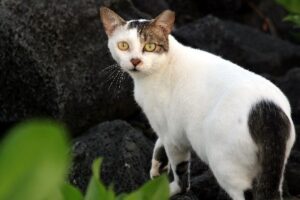 |
The most common species found in the UAE are:
- Bats (Order Chiroptera)
A – Egyptian Fruit Bat or Egyptian Rousette – Rousettus aegyptiacus (Geoffroy) (Family Pteropodidae)
B – Naked-rumped Tomb Bat or Naked-bellied Tomb Bat – Taphozous nudiventris (Cretzschmar) (Family Emballonuridae)
- Birds (link to “Birds” section)
- Cats
Feral cat – Felis catus Linnaeus (Family Felidae, Order Feliformia)
- Rabbits:
Wild Rabbit – Lepus capensis Linnaeus
- Rodents (link to “Rodents” section)
- Vibers (Family Viperidae, Order Squamata)
A – Horned Viper – Cerastes cerastes (Linnaeus)
B – Persiam Horned Viver or False horned viper – Pseudocerastes persicus (Dumeril, Biborn & Dumeril)
C – Desert Horned Viper – Cerastes gasperettii Leviton & Anderson
- Bats:
A – Egyptian Fruit Bat or Egyptian Rousette
General Description
|
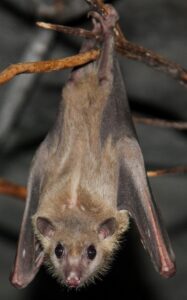
Credit: Lietuvos zoologijos sodas |
- Its wings are of a darker brown than its body and the wing membranes attach to the leg at the first toe.
- Males and females have similar coloration.
- The bat is well adapted to seeing in low light and possesses a highly developed sense of smell.
- Its eyes are large and well-developed, while its ears are considered medium-length.
Life Cycle and Common Characteristics
- Females give birth to only one offspring, on average, after a gestation period of 105–120 days.
- True to their name, these nocturnal mammals feed almost exclusively on soft fruits, such as dates, apples, and apricots.
- These bats are highly social species and live in colonies with thousands of other bats.
- Young bats cling to the female for about 3 weeks, until they can hang from branches on their own, and begin flying after 3 months.
- The bat has two breeding seasons: the first is from April to August, while the second season is from October to February.
- Females typically give birth to only a single offspring each year (called a “pup”), but twins are occasionally born, after a gestationperiod of around 115 to 120 days.
- The female carries the pup until it is six weeks old, which is when it can hang in the roost on its own.
- Offspring typically stay with the same colony as the parents for their entire lives.
- The average lifespan ranges from 8 to 10 years.
Damages and Medical Implications
|
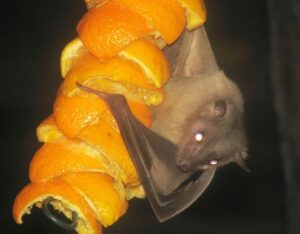
Credit: Arpingstone
|
B – Naked-Rumped Tomb Bat or Naked-bellied Tomb Bat
General Description
|
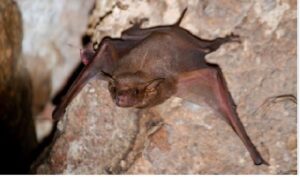
Credit: Rajesh Puttaswamaiah |
- Bats are greyish brown above, and paler below.
- They have strong-smelling glands in throat sacs which may be used in courtship.
- Parts of the belly are naked.
- Fur does not extend to the tail membrane.
- The lower back, abdomen, chin, throat, and cheeks are hairless.
- The short tail protrudes from the midpoint of the membrane.
- The head is fairly flat with a long, cone-shaped snout and a shallow depression between the large eyes.
- The lower lip has a grooved protuberance and the ears are triangular and backward-pointing.
- There is no nose leaf and the throat pouches are well-developed in the male but less so in the female.
- The fur is short and sleek and covers the whole body apart from the rump, lower belly, and hind limbs.
- The dorsal pelage is pale greyish-brown, deep brown, or rusty-brown and the ventral pelage is a paler color than the back.
- The wing membrane is dark brown and the tail projects freely from the upper surface of the interfemoral membrane.
Life Cycle and Common Characteristics
- For most of the year, males and females roost together, but the males move to roost elsewhere before the young are born.
- For the first few weeks, the newborn bat clings to its mother while she flies, but later, the young roost beside their mothers, remaining behind while their mothers forage.
- The gestation period is nine weeks, but the female may store the sperm during hibernation, with fertilization and pregnancy occurring in the spring.
- This bat species is agile, flying fast and high in open areas, hawking for insects.
- It is a social species, becoming active about half an hour before the sun sets, and streaming from the daytime roost shortly after sunset.
- Its diet includes beetles, moths, grasshoppers, crickets, cockroaches, and flying ants.
- It roosts gregariously in crevices between stones, in caves, crags, ruins, and old buildings.
Damages and Medical Implications
- The naked-rumped tomb bat roosts in old ruins, mosques, and wells.
2 – Birds (link to “Birds” section)
3 – Cats:
Feral Cat
General Description
|
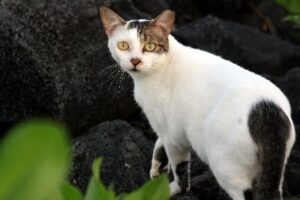
Credit: Brocken Inaglory |
Life Cycle and Common Characteristics
- In a free-roaming environment, feral cats avoid humans. They do not allow themselves to be handled or touched by humans, and back away or run when they are able to do so.
- If vats are trapped, they hiss, growl, bare their teeth, or strike out.
- They remain fairly hidden from humans and will not approach, although some feral cats gradually become more comfortable around humans who feed them regularly.
- Most feral cats have small home ranges, although some are more transient and travel long distances.
- Feral cats often live in groups called colonies, which are located close to food sources and shelter.
- The home ranges of male feral cats, which are generally two or three times larger than those of female cats, are on average under 10 ha, but can vary from almost 300 ha to under 1 ha. This variance is often due to breeding season, access to females, whether the cat is neutered, age, time of day, and availability of prey.
- Male cats reach sexual maturity at about 12 months.
- Females can reproduce at about 7 months.
- It can produce up to 3 litters a year, usually of 4 kittens but varying from 2 to 7.
- Most reproduction occurs between spring and summer.
- Birth follows a gestation period of 65 days.
Damages and Medical Implication
- Feral cats are susceptible to diseases and infections that could be detrimental to feline or human health. It includes rabies, toxoplasmosis, bartonellosis, several viruses (feline panleukopenia virus, feline immunodeficiency virus, feline leukemia virus), and feline respiratory disease
- Feral cats are one of the worst invasive species and one of the greatest threats to native wildlifein much of the world.
- Feral cats are either mesopredators(mid-ranking predators) or apex predators (top predators) in local ecosystems.
- They prey on a wide variety of both vertebratesand invertebrates, and typically prefer smaller animals with body weights under 100 g (they can prey on animals less than half their size), particularly mammals, birds, and lizards.
- Minor costs associated with the condemnation of sheep and lamb carcasses due to sarcosporidiosis and toxoplasmosis, which are carried by feral cats.
- Can injure and transmit disease to domestic cats.
- Carries parasites that can affect humans.
- High numbers in urban areas cause hygiene problems.
- Threatens small populations of critically endangered species.
- Carries toxoplasmosis, which is particularly harmful to marsupials, causing blindness, respiratory disorders, paralysis and loss of offspring.
- Rabbits
Wild Rabbit
General Description

Credit: Haplochromis, animalia.bio |
Credit: Shah Jahan |
- The Cape hare has a fine, soft coat that varies in color from light brown to reddish to sandy grey.
- The female is larger than the male, an example of sexual dimorphism.
- It has well-developed legs for leaping and running.
- It has large eyes and ears to look for threats from its environment. A white ring surrounds the eye.
Life Cycle and Common Characteristics
- After a 42-day-long pregnancy, the female gives birth to from 1 to 3 young (called leverets) per litter and may have 4 litters per year.
- Breeding occurs from January to June, with young produced from March to October. Breeding my occur at intervals of three months.
- The young hares are born with eyes open and are able to move about shortly after birth.
- It is a nocturnalherbivore, feeding on grass and various shrubs.
- It consumes its own fecal material to double the amount of time food spends in the digestive tract (Coprophagy). With this behavior, the rabbit extracts the maximum nourishment from its diet, and microbes present in the pellets also provide nutrients.
- Hares rarely live more than one year in the wild, and few individuals may live up to 5 years.
- Range generation period from 38 to 41 days.
- Range age at sexual or reproductive maturity is 7 to 9 months for both sexes.
Damages and Medical Implication
- Rabbits can cause damage throughout the year, depending on what plants are available. They eat succulent green vegetation, such as flowers, vegetables, and crops, during the growing season, and they may turn to trees or shrubs in winter.
- Rabbits can severely damage landscape plants, orchard trees, and other woody plants. They commonly bite off small branches and gnaw to reach the green inner bark.
5 – Rodents:
Link to Rodents
6 – Vipers:
A – Horned Viper – Cerastes cerastes (Linnaeus)
General Description
|
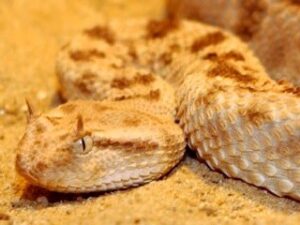
Credit: Jwinius
Credit: Holger Krisp |
- The colour pattern consists of a yellowish, pale grey, pinkish, reddish or pale brown ground colour, which almost always matches the substrate colour where the animal is found.
- Dorsally, a series of dark, semi-rectangular blotches run the length of the body. These blotches may or may not be fused into crossbars.
- The belly is white.
- The tail, which may have a black tip, is usually thin.
Life Cycle and Common Characteristics
- These snakes favor dry, sandy areas with sparse rockoutcroppings, and tend to avoid coarse sand. They are found around oases and up to an altitude of 1,500 metres.
- In captivity, mating was observed in April and always occurred while the animals were buried in the sand.
- This species is oviparous, laying 8–23 eggsthat hatch after 50 to 80 days of incubation. Females lay eggs under rocks and in abandoned rodent burrows.
- The hatchlingsmeasure 12–15 cm in length.
Damages and Medical Implication
- The venom of this horned viber causes swelling, necrosis, haemorrhage, nausea, vomiting, and haematuria.
- Venom yields vary, with ranges of 19–27 mg to 100 mg of dried venom being reported.
B – Persiam Horned Viver or False horned viper
General Description
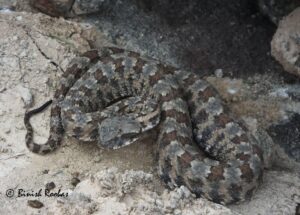
Credit: Broobas |

Credit: Zuhair, Stümpel, and Joger |
- Despite its serpentine body, its head is broad, flat, and it has short horns above its eyes.
- The fangs are folded like other snakes, but they lack a distinctive color pattern on their body and are often dark gray or tan in color.
- With a total length of 90 cm, it is the largest snake found in the UAE. Females are usually larger than males.
- The horned viper is very similar in appearance to the fake horned viper and is often referred to as a sand viper. The identification of these snakes causes some confusion, as some have horns while others do not have horns at all.
- The body is stocky, and the head is massive. It also has long, folded teeth and moves in an undulating manner in the soft sand, which is its favorite habitat.
Life Cycle and Common Characteristics
- It is oviparous, and sexually mature females lay 11-21 eggs. When produced, these already contain well-developed embryos, each of which can be as much as 8.5 cm in total length.
- Eggs hatch after only 30–32 days and measure 14 to 16 cm in total length.
- This snake species lives in the hills of the UAE. It is not found at altitudes less than 400 meters above sea level, and it does not venture out into the desert.
- They adapt well to the rocky environment they prefer.
- These snakes are found in the Emirates in the sandy deserts from the coast to the plains of the hills, where shade is not available.
- They are nocturnal reptiles and spend their days under anything that can provide them with a little protection from the glare of the sun. In the absence of shade, it buries itself in the sand by moving its ribs forward and upward at the same time, scattering the sand sideways, and allowing it to dive below the surface in a manner similar to a submarine. In a short time, she disappears, and only the eyes appear at the top of her head.
Damage and Medical Implication
- These snakes tend to avoid areas of human habitation.
- The venom of this snake exhibits strong hemorrhagic
- No antivenomis available for bites from this species.
General Description
|
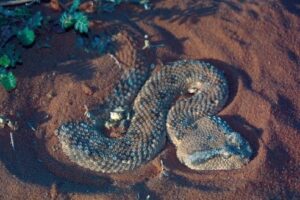
Credit: Zuhair, Stümpel, and Joger |
- The horned snake has two movable front fangs.
- The two horns of the snake are soft, flexible leather that can easily be bent.
Life Cycle and Common Characteristics
- The diet of this snake primarily consists of rodents, insects (particularly beetles), and lizards.
- The horned snake can move its two fangs forward outside the mouth and inward to insert them into its gums, and these two fangs help it quickly deliver the poison to the prey.
- The two horns of the snake are soft, flexible leather that can easily be bent, and they are not considered a weapon that it can use, while it can scare its enemies with it, and they may be to protect its big eyes from shocks.
- Snakes crawl sideways.
- Not all individual snakes have horns, and the horns are not related to the age of the snake. Both young and old have horns. It is likely that the horns are for male-only.
- It was noted that the horned snake is more ferocious and in self-defense than the one without horns.
Damages and Medical Implication
- It is considered one of the poisonous snakes whose bite must be avoided. It does not attack humans, and if you approach it, it escapes from you.
- If the snake is trapped, it turns around itself and rubs its scales against each other to make a sound to scare its enemies.

